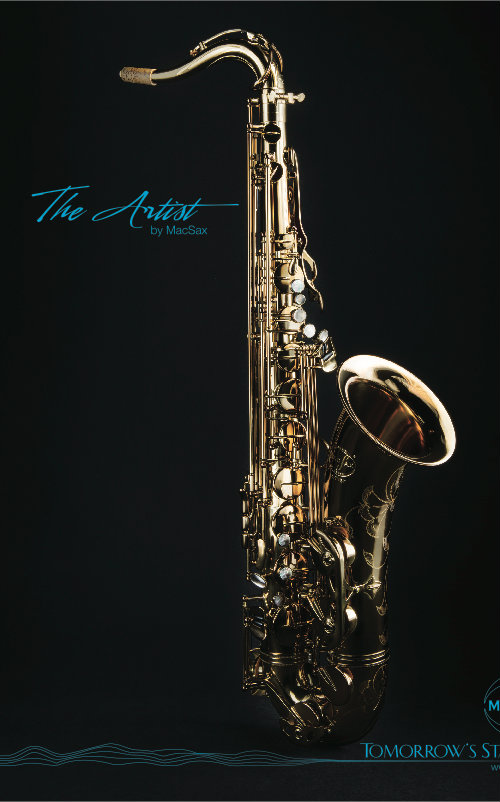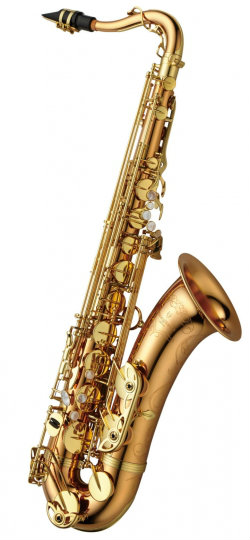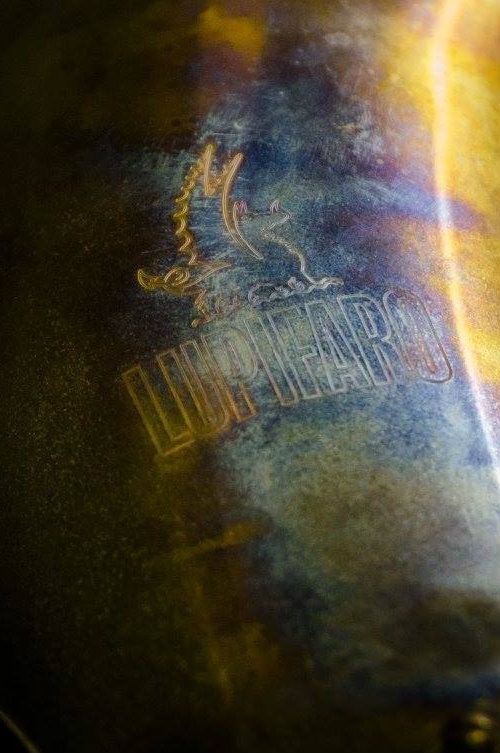NAMM 2016 Saxophone Gear Roundup
 Introduction
Introduction
This marks my 5th year attending NAMM (National Association of Music Merchants) and it keeps getting better and better every year. The 2016 NAMM show was yet another year filled with more exhibitors showcasing new and updated products ranging from saxophones, necks, ligatures, mouthpieces, reeds, and the list goes on. With only 4 days to see it all, I did my best to try as many products as possible but unfortunately, I was not able to get to everything. This year I saw more “vintage” saxophone offerings and noticed that although many brands seemed to look alike and use similar materials, the setup of the saxophone is what differentiated various brands at the show. I will be reviewing and revisiting some products I had a chance to try at the 2015 NAMM show as well as discussing some new products that have recently been launched for 2016. In addition to the reviewed products, I will list products at the show that I hope to test play at a later date as well as recommend you check out.
These products, in no particular order…
Macsax: The Artist

After having test played Macsax’s line of saxophones and settling on the Empyreal tenor as my favorite model, Greg Wilson and Eric Falcon at Macsax recommended I test play their new model called “The Artist.” According to MacSax, “The Artist model follows the vibrant and focused sound of the late 1950’s vintage French-made saxophones yet adds more ergonomic key-work, an exceptionally free blowing neck, and powerful projection.” Some features of this saxophone are: “Ribbed construction, hand hammered bell, Italian pisoni pads, blue steel springs, and shellac installed pads to name a few.” When I play tested The Artist series tenor, I noticed it was an incredibly free blowing from top to bottom. I found the action and key layout to feel comfortable and fluid under my fingers. Compared to the Empyreal model, I found that when I played this tenor, the sound was broader and projected well while the Empyreal had a bit more resistance (which I prefer) allowing me to achieve a more focused sound. Overall, The Artist tenor saxophone is a great new addition to the Macsax line up and at $2,495, it’s a great option for anyone looking to upgrade from a student to a professional saxophone.
More Info:
Yanagisawa T-WO20

Since hearing about the popularity of the new Yanagisawa WO alto saxophones from last year’s NAMM show, I was excited to finally get a chance to try out the new Yanagisawa WO tenor saxophone line. My first professional tenor saxophone (which I still own) is the Yanagisawa 991 tenor saxophone. While at the 2016 NAMM show, I had the chance to test play the Yanagisawa T-W020 which is the newer version of the Yanagisawa 992 (bronze model). Some of the enhancements Yanagisawa has made to the new WO series are as follows: new source of brass, readjustment of the bore and tone hole for better tonal response from high to low registers, redesigned front F key, additional stopper under the right side key to alleviate unneeded pressure, a new right pinky angle for smoother fingering, and new palm key plate. When I played the Yanagisawa T-W020, it felt just like my 991 but some of these enhancements I mentioned above made the T-W020 easier to get around on. The overall intonation was great and this tenor was very free-blowing with an even scale from low Bb to high F#. I highly recommend you check out the new Yanagisawa WO series tenor saxophones and for those of you who have the 991 series and are thinking about upgrading to this model, I recommend play testing the various finishes first to see if you notice a significant difference. I personally would not upgrade to the W010 from my 991 series Yanagisawa because the difference was not significant for me but after playing the W020 model, I did prefer the overall response and believe that possibly the sterling silver models would make enough of a difference to make me switch to the new WO model.
More Info:
http://www.yanagisawasax.co.jp/e_newproducts.html
Lefreque

While trying out various mouthpieces from CE winds and saxophones from Lupifaro, I noticed a booth around the corner with a product called a LefreQue. The LefreQue comes in a few sizes and different finishes such as: Brass, silver plated, red brass, sterling silver, gold plated, etc. Hans Kuijt, the inventor of the LefreQue, explained to me that the LefreQue is a sound bridge made up of two metal elements that address sound breaches that occur at different parts of the instrument affecting the sound quality and tuning of the tone. Hans informed me that you put the LefreQue on an instrument such as a saxophone using a special elastic band. He told me that cork is a material that does not pass on sound so using the LefreQue to touch your mouthpiece and circumvent the cork, will result in a better sound and tuning. I tried the brass, silver plated and red brass and I found that the red brass made the most difference for me. I found that with the LefreQue, the sound resonated a bit more resulting in a more tonal colors. For me I did not think the LefreQue significantly improved the tuning and tone but I did notice it enough to where i can see why many woodwind players have started to adopt this product.
More Info:
Ochres X series

Ochres, like Sahduoo, was another new exhibitor to NAMM this year and was showcasing their line of professional saxophones. The model that stood out to me was the X series OCT-N5VX. This tenor saxophone had a vintage finish with abalone key touches. Unique to the Ochres model was an alternate F# key that was larger than I have seen on any saxophone and had a wood key touch instead of a pearl or metal. In addition, this saxophone had a 24k gold medal stamped above the Ochres name on the front of the bell with a Mark VI like floral engraving. This tenor sonically had one of the best sounds I thought at the show. The level of resistance, edge, and core I found on this model reminded me most of the characteristics many players are looking for when they are searching for a great vintage Conn, King, or Selmer saxophone. I found the key-work comfortable and easy to get use to but would have the spring tension lighter for my personal preference. In terms of materials, this saxophone is setup with blue steel springs and pisoni pads installed with shellac. I am looking forward to play testing this saxophone again and hope to review one in further detail later this year.
More Info:
Macsax FL 65

Eric has introduced and collaborated with many companies looking to design and manufacturer their own line of mouthpieces. One of Eric’s new mouthpieces is the Macsax FL 65. Since so many players are searching for a vintage link or alternative to a vintage link, Eric created this mouthpiece inspired by the Florida no USA vintage Super Tone Master. I have played on an old hard rubber slant Otto link that Eric worked on and was excited to try this FL 65 mouthpiece. I found that I was able to push a lot of air thru this mouthpiece without much resistance but get a really focused sound that was easy to control. I found this FL 65 to have a lot of edge if you pushed it and like so many of Eric’s mouthpieces, the FL 65 offered many of the qualities you are looking for in a great mouthpiece without the issues you would find with various vintage mouthpieces. If you are currently in the market for a metal mouthpiece and specifically like vintage links, I would highly recommend you check out the Macsax FL 65.
More Info:
Sahduoo XT series

While searching thru the NAMM app before the show, I noticed there was a new saxophone manufacturer from Taiwan called Sahduoo. When I stopped by Sahduoo’s booth, they had their student and professional model alto’s, tenor’s and soprano saxophones as well as their own line of mouthpieces. I tried a few of their hard rubber tenor mouthpieces which I thought played well overall. I played two of their professional model tenor saxophones known as the XT series. The XT series tenor came in an array of finishes from gold lacquer, black lacquer with gold keys, matte finish, and un-lacquered to name a few. I ended up liking one of their newer finishes which was a matte finish with black mother of pearl. From first looking at the XT series, the key-work and appearance reminded me of a Mark VI copy combined with various keys and features I see on other Taiwanese saxophones today. When I started playing this saxophone, I found the overall setup felt good and the sound leaned a bit on the brighter side. This saxophone played well from low Bb to High F# and was stable and consistent thru-ought. I did recommend a few changes that I think many players would like to see on the XT series but was impressed with the craftsmanship and Sahduoo’s team’s interest in getting players feedback on how they can better improve their saxophones. I would highly recommend checking out their website to find out more information and hope to in the future spend more time playing the XT series to gain a better understanding of what this saxophone has to offer.
More Info:
Lupifaro Baritone Saxophone

It was great to see Luca Cardinali, the creator of the Lupifaro saxophone line. Since the Platinum series saxophones were introduced at the NAMM show almost 3 years ago, they have gotten more and more popular. This year in particular, Luca introduce the new Platinum baritone saxophone. The Platinum series is meant for those players who enjoy vintage Selmer’s but want the modern enhancements included. This baritone saxophone, unlike many new professional baritone saxophones built today is without a low A key. Similar to the discussion how many players prefer vintage saxophones without the high F# key, many baritone players who are coming from a vintage Selmer or Conn, prefer no low A and just Bb. The various students and professional saxophone players that came by to try the Lupifaro Platinum baritone saxophone said they enjoyed the overall ergonomics and tonal colors. Those players who specifically play on low Bb bari’s and are looking for a modern version should check out the Lupifaro Platinum baritone saxophone.
More Info:
Jazzlab “Deflector”

Since picking up the first version of the Saxholder neckstrap which has become incredibly popular in the saxophone community, I decided to stop by the booth to see what new products Jazzlab had to offer. At the Jazzlab booth, I saw a product called The Deflector. The Deflector reminded me of the Ploeger sax sound mirror which I used in the past. I tried out the Deflector and found it easy to put on the saxophone bell and secure it in place. The Deflector was very easy to adjust whether you wanted it to be close to the bell or not. Overall, I could hear the sound being deflected back in my direction which was extremely great with all the noise going on at the NAMM show. Since the Deflector I tried at the show was just a prototype, I am excited to see when the final version comes out on the market because I intend to pick one up.
More Info:
ReedGeek “Klangbogen”

In addition to the widely popular ReedGeek, Mauro has released and has been perfecting his new product called the Klangbogen. I have been test playing this Klangbogen for over a year now and have been trying it on various saxophones. I can say that the overall effect depends on the particular saxophone and can be noticed in the low’s and the high’s at various extreme’s. I used the Klangbogen on my Mark VI tenor and I found the low B and Bb to play more stable as well as found a similar result when playing in the palm keys. I recommend you email Mauro or find a retailer by you to try a Klangbogen and make sure it fits your saxophone lyre holder. I will have a more detailed review coming out this year but am excited that Mauro has come out with another product to make our saxophone playing lives easier.
More Info:
http://www.reedgeek.com/klangbogen/
Gottsu Sepia VI mouthpieces

The Gottsu booth was one of the first booths I stopped at when I attended my first NAMM show. Since trying his first Sepia Tone mouthpiece, I wanted stop by the booth to say hello to Mr. Gottsu and see what new products he had to offer. One of the mouthpieces Mr. Gottsu recommended I try was his popular Sepia Tone VI mouthpiece but in a marble finish. When I played tested this mouthpiece and compared it to my Otto Link, the Sepia Tone VI played easily and at the same time I liked the overall tonal colors I could achieve on this mouthpiece. Although I found it easy to play through-out the entire horn, I found the Sepia Tone VI had a bit more resistance in the palm keys than I was not accustomed to on my Otto link hard rubber mouthpiece. I found the Sepia Tone VI could be dark when you wanted it to or brighter if you pushed it. I did not find this mouthpiece leaned towards either too dark or too bright and was very versatile. I would recommend checking out Mr. Gottsu’s hard rubber as well as metal mouthpieces.
More Info:
http://www.gottsu-japan.com/home-english
Additional Products to check out
- Marmaduke alto and tenor mouthpieces (http://kyotobeauty.ocnk.biz/product-list/2)
- Ishimori Woodstone saxophones (http://www.wood-stone.jp/)
- Rampone & Cazzani (http://www.ramponecazzani.com/eng/index.php)
- Trevor James saxophones (new neck coming soon!)( http://tjsaxes.co.uk/)
- Forestone saxophones (http://www.forestone-saxophone.com/index.html)
- Vandoren V21 Reeds (http://www.vandoren-en.com/V21-Saxophone-Reeds-New_a834.html)
- Cannonball 20 year anniversary saxophones (http://www.cannonballmusic.com/index.php)
- P Mauriat Master 97 saxophone (http://pmauriatmusic.com/en/products/item/3-alto/108-master-97)
- Joel Harrison ligature (http://www.sax-works.com/)
- Silverstein mouthpiece’s (http://www.silversteinworks.com/mouthpiece-le/)
- CE Winds saxophones and mouthpieces (http://www.cewinds.com/)
- Theo Wanne Slant Sig tenor mouthpiece (http://theowanne.com/shop/)
- Horae saxophones (http://horaewinds.com/) [Sorry(!), but this web page has disappeared since the original publication of this article]
- Nadir Winds mouthpieces (http://nadirsaxwind.com/)
Conclusion
The 2016 NAMM Show was another great year filled with new artists, new products, and most importantly new exhibitors showcasing their saxophones, ligatures, reeds, necks, mouthpieces, neck straps, and the list goes on. What I have seen over the past 5 years, besides the introduction of new products, is the improvement of current saxophone models as well as products designed to correct problems still seen on new horns manufactured today. This is important because there are more saxophones coming out on the market which is leading to additional research and development by manufacturers to set their saxophones apart resulting in better horns to the player. Unfortunately, I was not able to visit every booth I wanted to and spend the amount of time I would have liked to test play various saxophone products.
To any of the manufacturers I met at NAMM, if I did not include you in this list, this is not a reflection on your product, it just came down to time. If you would like me to review your product specifically or have any questions, please feel free to contact me using the information from my author bio below.
Again, another great NAMM Show and I can’t wait to see what NAMM 2017 has in store for us saxophonists next year!





